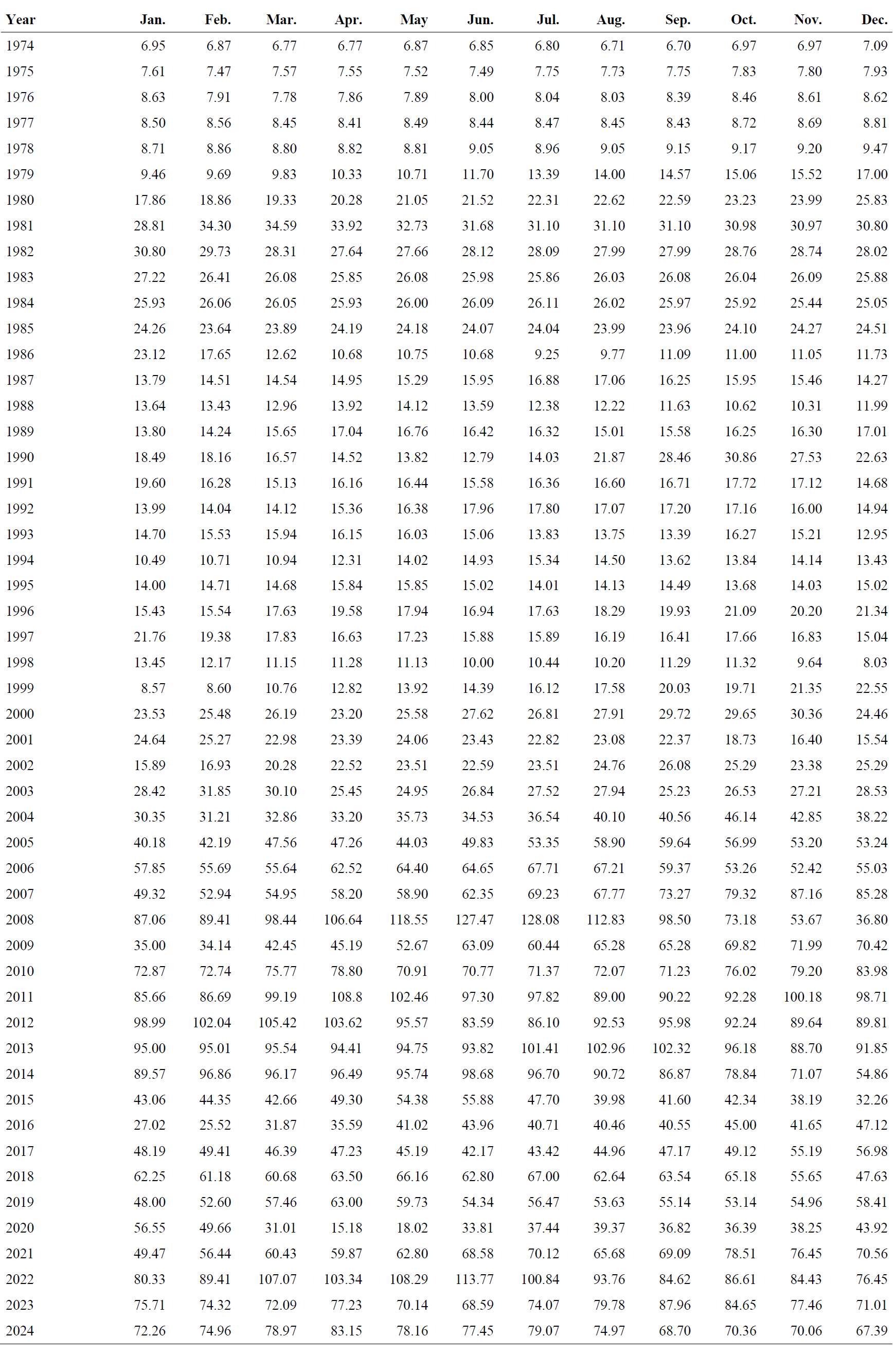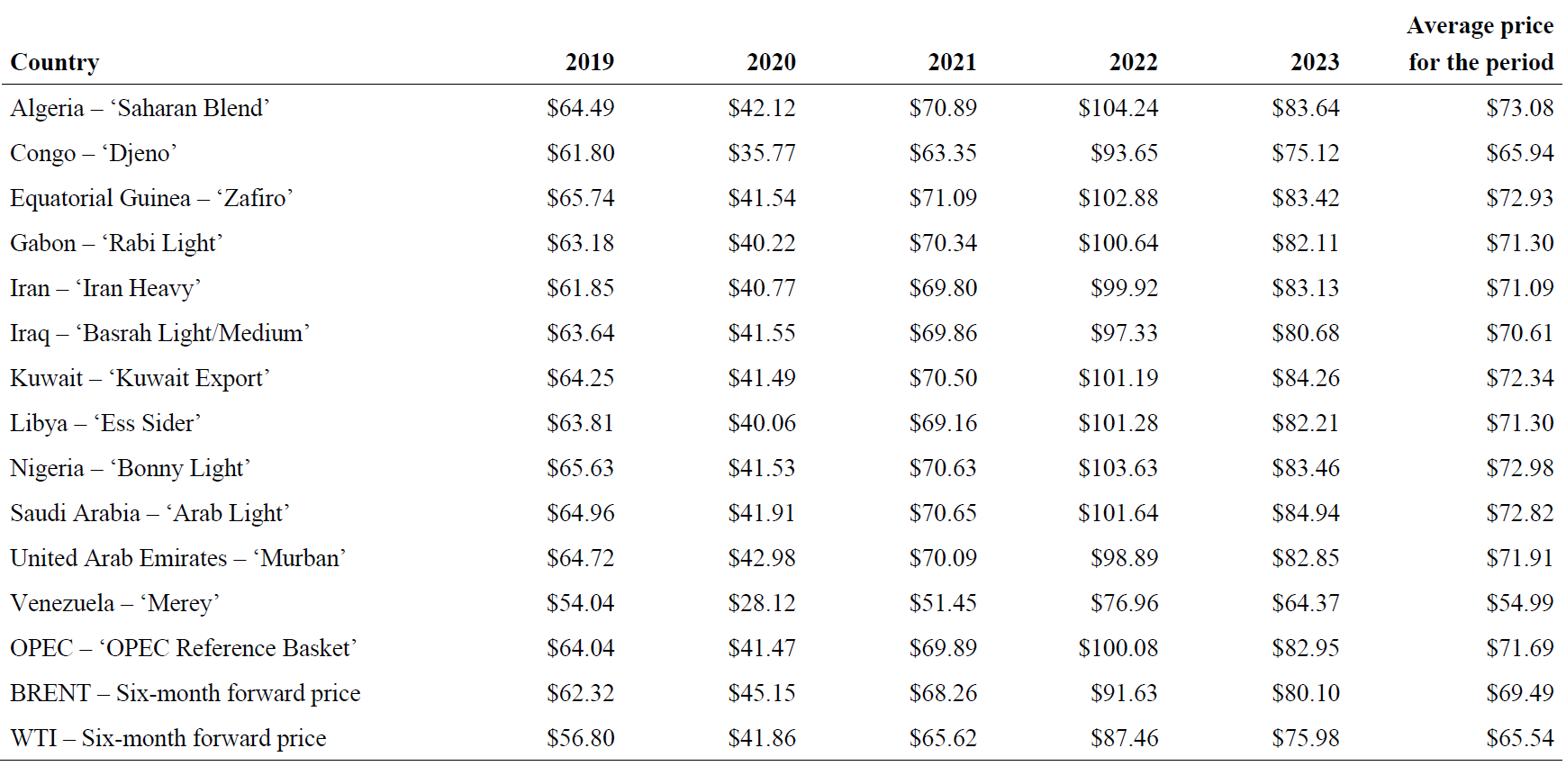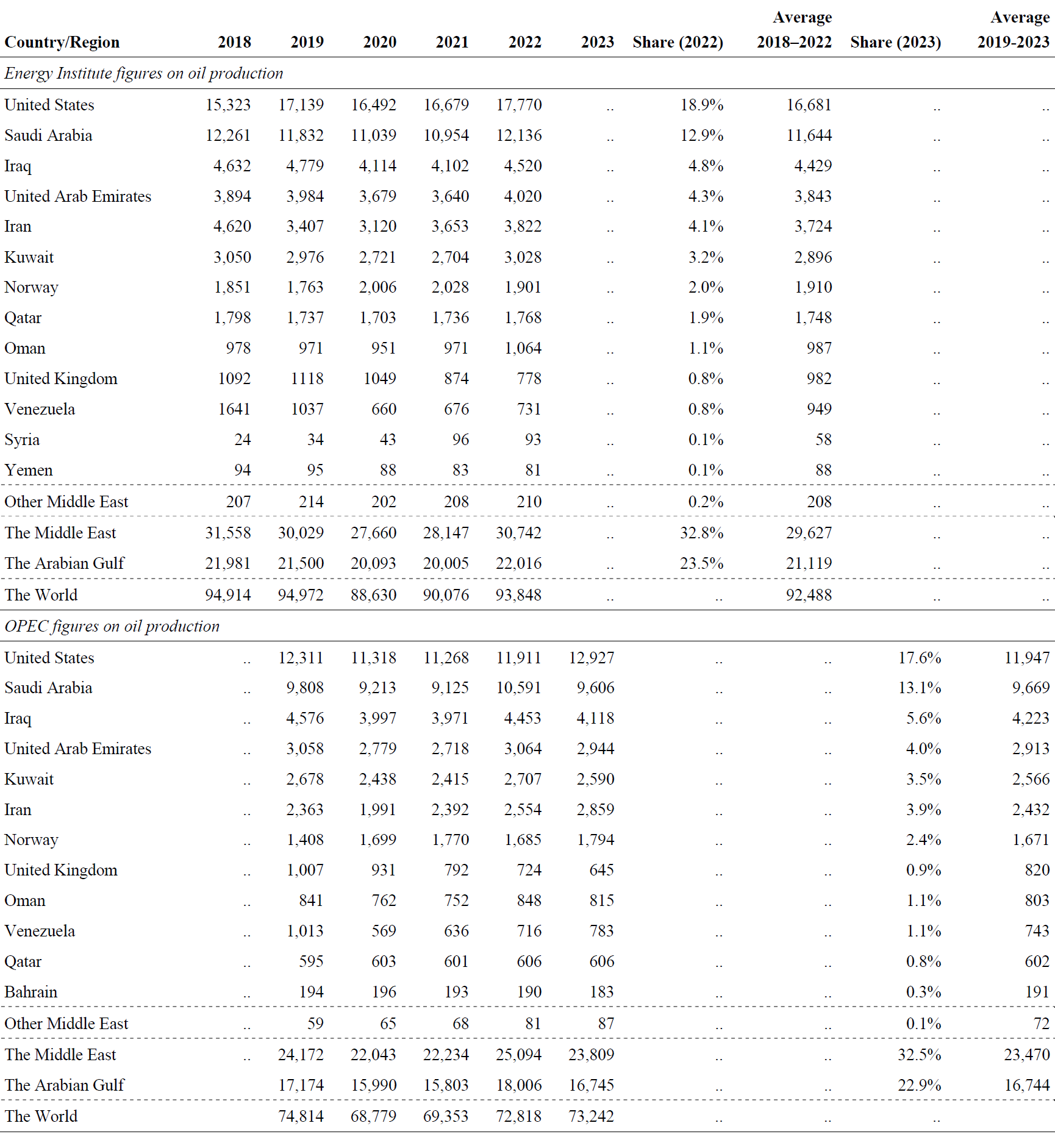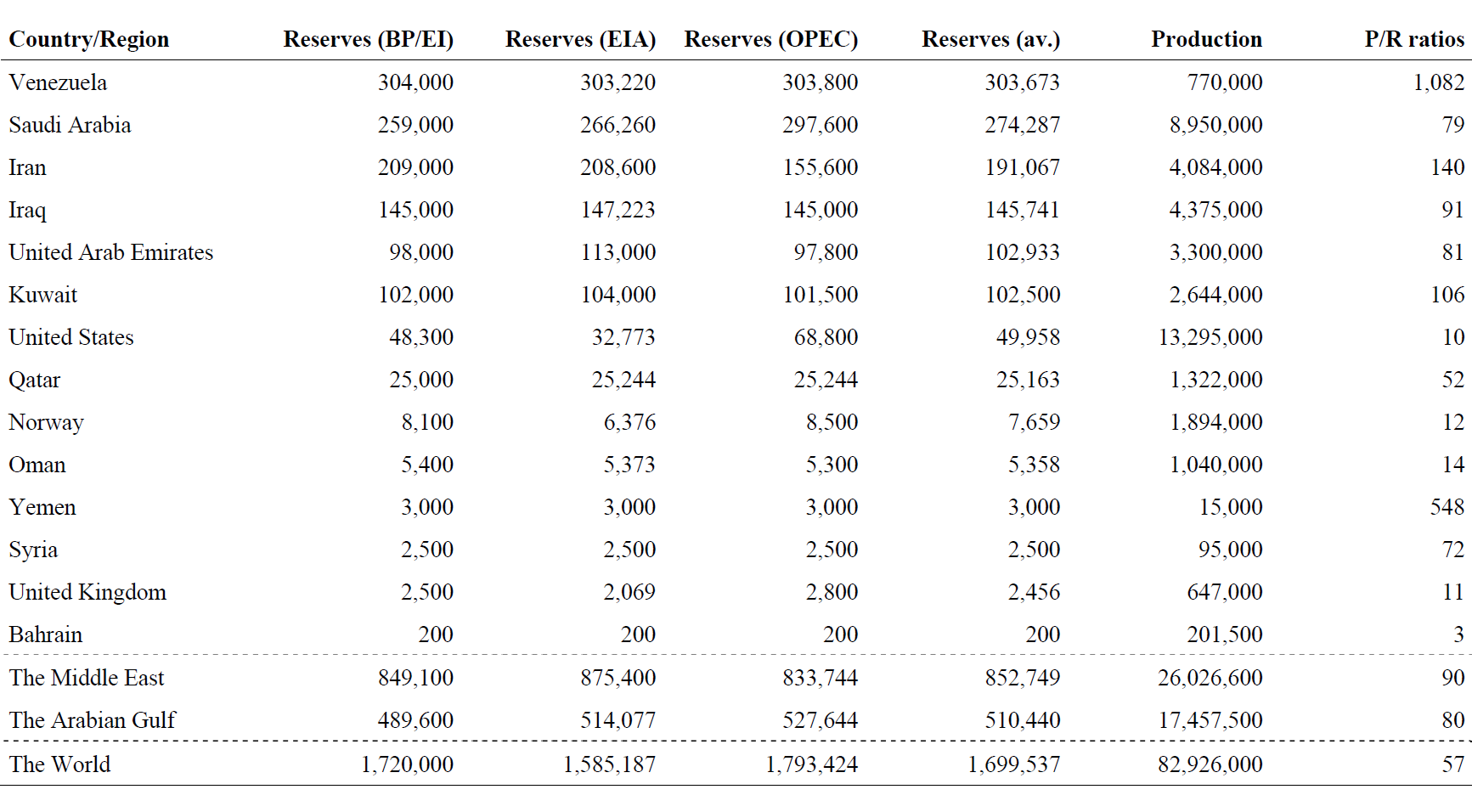Information depicted is the latest publicly available as of early 2025.
Figures
Figure 1
Real per barrel oil prices, 1969 to 2024

Notes The widely reported price fluctuations (e.g., Baumeister & Kilian, 2016; Caldara, Cavallo, & Iacoviello, 2019) are here somewhat ironed out; the dark horizontal line represents the average price for the period.
Allocating oil-rent (“resource wealth” matters)
📕 “The Arabian Gulf Social Contract” →
📕 “Arabian Gulf sovereign wealth” →
Oil’s ‘blessings’ & the American dollar standard
📕 “Political maps of Arabia” →
Tables
Table 1
Crude Oil First Purchase Prices (US$ dollars per barrel)

Notes Public domain data from EIA (2025); prices shown are for West Texas Intermediate (WTI) crude oil (for comparisons with other crude variant spot prices, see Table 2); informed by: Baumeister and Kilian (2016) and Caldara, Cavallo, and Iacoviello (2019).
Table 2
OPEC Reference Basket Prices (and other spot prices, in $US per barrel)

Notes Not only do Arabian Gulf blends fetch more money but, the extraction costs in the Gulf are widely considered to be the cheapest in the world (see, e.g., Asker, Collard-Wexler, & De Loecker, 2017); public domain data from OPEC (2024).
Table 3
Oil Production (in thousands of barrels per day)

Notes Public domain data from the Energy Institute (2024) and OPEC (2024).
Table 4
Oil Reserves (reserves in millions of barrels, with production to reserves ratios in years)

Notes Public domain data from BP (2022), EIA (2024), Energy Institute (2024) and OPEC (2024); figures for production are in barrels per day (not, as with reserves, depicted in millions of barrels).
References
Abdellatif, A., Pagliani, P., & Hsu, E. (2019). Leaving No One Behind: Towards Inclusive Citizenship in Arab Countries. United Nations Development Program.
Aburish, S. K. (1994). The Rise, Corruption and Coming Fall of the House of Saud. Bloomsbury.
Al-Rasheed, M. (2006). Contesting the Saudi State: Islamic Voices from a New Generation. Cambridge University Press.
Al-Rasheed, M. (2020). Brute Force and Hollow Reforms in Saudi Arabia. Current history, 119(821), 331–337. https://doi.org/10.1525/curh.2020.119.821.331
Al-Salim, A. (2023). The Gulf’s twin failings: Innovation and private sector employment for nationals. Middle East Institute. https://www.mei.edu/publications/gulfs-twin-failings-innovation-and-private-sector-employment-nationals
Al Shouk, A. (2024, June 20). Emiratisation deadline looms as larger private companies look to fulfil national targets. The National. https://www.thenationalnews.com/news/uae/2024/06/20/emiratisation-deadline-july/
Alaref, J. (2024). Social Protection in Saudi Arabia. In J. Sfakianakis (Ed.), The Economy of Saudi Arabia in the 21st Century: Prospects and Realities (pp. 218–257). Oxford University Press.
Alsawafi, A. M. (2016). Exploring the challenges and perceptions of Al Rustaq College of Applied Sciences students towards Omani women’s empowerment in the tourism sector. Tourism Management Perspectives, 20(1), 246–250. http://doi.org/10.1016/j.tmp.2016.10.004
Alshateri, A. (2021). Davidson, C. “From Sheikhs to Sultanism: Statecraft and Authority in Saudi Arabia and the UAE” [Book review]. American Diplomacy. https://americandiplomacy.web.unc.edu/2021/11/from-sheikhs-to-sultanism/
Arab Monetary Fund. (2025). Economic Statistics [Dataset]. https://www.amf.org.ae/en/arabic_economic_database
Asker, J., Collard-Wexler, A., & De Loecker, J. (2017). Market power, production (mis)allocation and OPEC. National Bureau of Economic Research, Working Paper Series, 1(September, w23801), 1–54. https://doi.org/10.3386/w23801
Assidmi, L. M., & Wolgamuth, E. (2017). Uncovering the Dynamics of the Saudi Youth Unemployment Crisis. Systemic practice and action research, 30(2), 173–186. https://doi.org/10.1007/s11213-016-9389-0
Atef, T., & Al Balushi, M. (2017). Omani tourism and hospitality students’ employment intentions and job preferences: Ramifications on Omanization plans. Quality assurance in education, 25(4), 440–461. http://doi.org/10.1108/QAE-04-2016-0022
Baumeister, C., & Kilian, L. (2016). Forty Years of Oil Price Fluctuations: Why the Price of Oil May Still Surprise Us. The Journal of Economic Perspectives, 30(1), 139–160. https://doi.org/10.1257/jep.30.1.139
Beblawi, H., & Luciani, G. (Eds.). (1987). The Rentier State. Croom Helm.
Bekhradnia, B. (2016). International university rankings: For good or ill? Higher Education Policy Institute, 1(89), 1–32.
Benítez-Márquez, M.-D., Sánchez-Teba, E. M., Coronado-Maldonado, I., & Sung, W.-W. (2022). An alternative index to the global competitiveness index. PloS one, 17(3), 1–19. https://doi.org/10.1371/journal.pone.0265045
Benjamin, D., & Simon, S. (2024, May 20). New 9/11 Evidence Points to Deep Saudi Complicity. The Atlantic. https://www.theatlantic.com/ideas/archive/2024/05/september-11-attacks-saudi-arabia-lawsuit/678430/
Bertelsmann Stiftung. (2024). BTI 2004-2024 Country Reports [Dataset]. https://bti-project.org/en/reports/global-dashboard
Boucher, D., & Kelly, P. (1994). The Social Contract from Hobbes to Rawls. Routledge.
BP. (2021). Statistical Review of World Energy [Dataset]. https://www.bp.com/en/global/corporate/energy-economics.html
BP. (2022). Statistical Review of World Energy. British Petroleum.
Bradshaw, T. (2022). [Book Review] Davidson, C. “From Sheikhs to Sultanism: Statecraft and Authority in Saudi Arabia and the UAE”. Middle Eastern Studies, 58(1), 687–688. https://doi.org/10.1080/00263206.2021.2017288
Caldara, D., Cavallo, M., & Iacoviello, M. (2019). Oil price elasticities and oil price fluctuations. Journal of Monetary Economics, 103(May), 1–20. https://doi.org/10.1016/j.jmoneco.2018.08.004
Chirikov, I. (2023). Does conflict of interest distort global university rankings? Higher Education, 86(4), 791–808. https://doi.org/10.1007/s10734-022-00942-5
Choucair Vizoso, J. (2020). A Slice of Knafeh for Everyone? A Critical Introduction to Universal Basic Income in MENA. Arab Reform Initiative. https://opendocs.ids.ac.uk/opendocs/handle/20.500.12413/17040
Coates Ulrichsen, K. (2011). Insecure Gulf: The End of Certainty and the Transition to the Post-Oil Era. Oxford University Press.
Cook, L., & Dimitrov, M. (2017). The Social Contract Revisited: Evidence from Communist and State Capitalist Economies. Europe-Asia studies, 69(1), 8–26. https://doi.org/10.1080/09668136.2016.1267714
Cook, S. (2021, January 29). How Saudi Arabia Gets Away With Murder. Foreign Policy. https://foreignpolicy.com/2021/01/29/how-saudi-arabia-gets-away-with-murder/
Cooley, A., & Snyder, J. (Eds.). (2015). Ranking the World: Grading States as a Tool of Global Governance. Cambridge University Press.
Cooley, J. K. (1994, March 29). Aburish, S. “The Rise, Corruption and Coming Fall of the House of Saud” [Book review]. The New York times. https://www.nytimes.com/1994/03/29/style/IHT-books-the-rise-corruption-and-coming-fall-of-the-house-of-saud.html
Cortés, P., Kasoolu, S., & Pan, C. (2023). Labor Market Nationalization Policies and Exporting Firm Outcomes: Evidence from Saudi Arabia. Economic development and cultural change, 71(4), 1397–1426. https://doi.org/10.1086/719835
Crystal, J. (2020). Nationalism in the Persian Gulf’s oil monarchies. In M. Kamrava (Ed.), Routledge Handbook of Persian Gulf Politics (280–291). Taylor & Francis Group.
Davidson, C. (2012). After the Sheikhs: The Coming Collapse of the Gulf Monarchies. C. Hurst and Company.
Davidson, C. (2021). From Sheikhs to Sultanism: statecraft and authority in Saudi Arabia and the UAE. C. Hurst & Co. Publishers.
Dettmer, J. (1995). Aburish, S. “The Rise, Corruption and Coming Fall of the House of Saud” [Book review] Insight on the News, 11(30).
Diop, A., Johnston, T., & Le, K. T. (2015). Reform of the Kafāla System: A Survey Experiment from Qatar. Journal of Arabian Studies, 5(2), 116–137. https://doi.org/10.1080/21534764.2015.1113681
Diwan, I. (2016). Saudi Arabia’s Reform Path. Project Syndicate. https://www.project-syndicate.org/commentary/saudi-arabia-vision-2030-reform-plan-by-ishac-diwan-2016-04
Durand-Lasserve, O. (2022). Nationalization of the private sector labor force, quotas, matching and public jobs, an illustration with Saudi Arabia. The Quarterly review of economics and finance, 86, 98–117. https://doi.org/10.1016/j.qref.2022.06.004
EIA. (2024). International, Petroleum and other liquids [Dataset: U.S. Energy Information Administration]. https://www.eia.gov/international/data/
EIA. (2025). Real Petroleum Prices [Dataset: Energy Information Agency]. https://www.eia.gov/outlooks/steo/realprices/
EIU. (2024). Democracy Index 2023: Age of conflict. Economist Intelligence Unit. https://www.eiu.com/n/campaigns/democracy-index-2023/
EIU. (2025a). EIU Democracy Indices, 2018-2024 [Dataset: EIU Democracy Indices]. Economist Intelligence Unit.
EIU. (2025b). Democracy Index 2024: What’s wrong with representative democracy? Economist Intelligence Unit.
Energy Institute. (2024). Statistical Review of World Energy [Dataset]. https://www.energyinst.org/statistical-review/resources-and-data-downloads
Erumban, A. A., & Al-Mejren, A. (2024). Expatriate jobs and productivity: Evidence from two GCC economies. Structural Change and Economic Dynamics, 71(online first), 248–260. https://doi.org/10.1016/j.strueco.2024.07.007
Eurostat. (2025). Database [Dataset]. https://ec.europa.eu/eurostat/data/database
Ewers, M., & Dicce, R. (2020). Revisiting the Gulf’s divided labor markets. In M. Kamrava (Ed.), Routledge Handbook of Persian Gulf Politics (232–247). Taylor & Francis Group.
Foreman, C. (2016, April 26). Riyadh to salvage economic cities and financial district. MEED. https://www.meed.com/riyadh-to-salvage-economic-cities-and-financial-district/
Fraser Institute. (2024). The Human Freedom Index. The Fraser Institute.
Freedom House. (2024a). Freedom on the Net [Dataset]. https://freedomhouse.org/countries/freedom-net/scores
Freedom House. (2024b). World Freedom Index [Dataset]. https://freedomhouse.org/report/freedom-world#Data
Gardner, D. (2017, November 5). Mohammed bin Salman aims to win Saudi game of thrones. The Financial Times. https://www.ft.com/content/a13da61e-c233-11e7-a1d2-6786f39ef675
Global Media Insight. (2024). UAE Population 2024 (Key Statistics). Global Media Insight. https://www.globalmediainsight.com/blog/uae-population-statistics/
Global SWF. (2024). Countries Ranking [Dataset]. https://globalswf.com/countries
Goldenberg, S. (2016, February 16). Masdar’s zero-carbon dream could become world’s first green ghost town. The Guardian. https://www.theguardian.com/environment/2016/feb/16/masdars-zero-carbon-dream-could-become-worlds-first-green-ghost-town
Government of Abu Dhabi. (2008). Plan Abu Dhabi 2030: Urban Structure Framework Plan. Abu Dhabi Urban Planning Council.
Government of Bahrain. (2024). The National Labour Market Plan 2023-2026. Labour Market Regulatory Authority.
Government of Bahrain. (2025). Open Data Portal [Dataset]. Information & eGovernment Authority. https://www.data.gov.bh/
Government of Dubai. (2022). Number of Population Estimated by Nationality [Dataset]. https://www.dsc.gov.ae/en-us/Themes/Pages/Population-and-Vital-Statistics.aspx?Theme=42
Government of Kuwait. (2018). Decent Work: Country Programme For Kuwait. Government of Kuwait.
Government of Kuwait. (2024). Labour Market Statistics [Dataset: Central Statistical Bureau]. https://www.csb.gov.kw/Pages/Statistics_en?ID=64&ParentCatID=1
Government of Kuwait. (2025). Open Data [Dataset]. https://e.gov.kw/sites/kgoenglish/Pages/OtherTopics/OpenData.aspx
Government of Oman. (2022). Skills needs in the Oman labour market: An employer survey. Oman Chamber of Commerce and Industry.
Government of Oman. (2025). Population statistics [Dataset: National Centre For Statistics & Information]. https://data.gov.om/
Government of Qatar. (2025). Open Data Portal [Dataset: Planning and Statistics Authority]. https://www.data.gov.qa
Government of Qatar. (2008). Qatar National Vision 2030. Doha: General Secretariat for Development Planning.
Government of Saudi Arabia. (2016a). National Transformation Program. Riyadh: Council of Economic and Development Affairs.
Government of Saudi Arabia. (2016b). Vision 2030. Council of Economic and Development Affairs.
Government of the United Arab Emirates. (2008). The Abu Dhabi Economic Vision 2030. Abu Dhabi Council for Economic Development.
Government of the United Arab Emirates. (2025). Open Data [Dataset]. Ministry of Economy. https://www.moec.gov.ae/en/open-data
Griffin, M., Hodgson, R., & Sivam, S. (2021). Career incentives, career deterrents, and cultural blocks: An investigation of factors impacting female Emirati students’ perceptions of tourism. Journal of Human Resources in Hospitality & Tourism, 20(3), 472–496. http://doi.org/10.1080/15332845.2021.1923945
Gulf Research Centre. (2024). Gulf Labour Markets, Migration and Population programme [Dataset]. https://gulfmigration.grc.net/
Gunitsky, S. (2015, June 23). How do you measure ‘democracy’? The Washington Post. https://www.washingtonpost.com/news/monkey-cage/wp/2015/06/23/how-do-you-measure-democracy/
Halliday, F. (1974). Arabia without Sultans. Penguin.
Hampton, J. (1987). Hobbes and the Social Contract Tradition. Cambridge University Press.
Hazelkorn, E. (2019). University Rankings: there is room for error and “malpractice”. Elephant in the Lab. https://doi.org/10.5281/zenodo.2592196
Herb, M. (2014). The Wages of Oil: Parliaments and Economic Development in Kuwait and the UAE. Cornell University Press.
Herre, B. (2024). Democracy data: how sources differ and when to use which one. OurWorldinData.org. https://ourworldindata.org/democracies-measurement
Hertog, S. (2011). The costs of counter-revolution in the GCC. Center for International Studies. https://www.sciencespo.fr/ceri/sites/sciencespo.fr.ceri/files/art_sh.pdf
Hertog, S. (2018). Can we Saudize the labour market without damaging the private sector? Retrieved from http://eprints.lse.ac.uk/id/eprint/101471
Hertog, S. (2020). Reforming wealth distribution in Kuwait: estimating costs and impacts. Kuwait Programme paper series, LSE Politics Centre (5). https://eprints.lse.ac.uk/105564/
Hertog, S. (2024). The Political Economy of Reforms under Vision 2030. In J. Sfakianakis (Ed.), The Economy of Saudi Arabia in the 21st Century: Prospects and Realities (pp. 359–380). Oxford University Press.
Hickey, S., & King, S. (2016). Understanding Social Accountability: Politics, Power and Building New Social Contracts. The Journal of Development Studies, 52(8), 1225–1240. https://doi.org/10.1080/00220388.2015.1134778
Holmey, O. (2019, March 5). Middle East: The battle for regional dominance resumes. Euromoney. https://www.euromoney.com/article/b1dd590zgftzf6/middle-east-the-battle-for-regional-dominance-resumes
Huntington, S. P. (1993). The clash of civilizations? Foreign Affairs, 72(3), 22–49. https://doi.org/10.2307/20045621
IEA. (2025). Data and statistics [Dataset: The International Energy Agency]. https://www.iea.org/data-and-statistics/data-sets
Ikenberry, G. J. (2015). Ranking the World: Grading States as a Tool of Global Governance [Book Review]. Foreign Affairs, 94(5), 180–180. https://www.jstor.org/stable/24483753
IMF. (2023). Kuwait: 2023 Article IV Consultation. IMF Staff Country Reports, 2023(331). https://doi.org/10.5089/9798400254680.002
IMF. (2024a). Gulf Cooperation Council: Pursuing Visions Amid Geopolitical Turbulence. International Monetary Fund working papers, 2024(66), 1–74. https://doi.org/10.5089/9798400295744.007
IMF. (2024b). Qatar: 2023 Article IV Consultation. IMF Country Report, 2024(24/43). https://www.imf.org/en/Publications/CR/Issues/2024/02/06/Qatar-2023-Article-IV-Consultation-Press-Release-and-Staff-Report-544471
IMF. (2024c). Saudi Arabia: 2024 Article IV Consultation. IMF Staff Country Reports, 2024(323). https://doi.org/10.5089/9798400252099.002
IMF. (2024d). United Arab Emirates: 2024 Article IV Consultation. IMF Staff Country Reports, 2024(325). https://doi.org/10.5089/9798400293245.002
IMF. (2024e). World Economic Outlook [Dataset]. https://www.imf.org/en/Publications/WEO/weo-database/2024/April
IMF. (2024f). World Economic Outlook [Dataset]. https://www.imf.org/en/Publications/WEO/weo-database/2024/April
IMF. (2025). Oman: 2024 Article IV Consultation. IMF Staff Country Reports, 2025(13). https://doi.org/10.5089/9798400298318.002
Kamrava, M. (2018). Oil and Institutional Stasis in the Persian Gulf. Journal of Arabian Studies, 8(1), 1–12. https://10.1080/21534764.2018.1546929
Kamrava, M. (Ed.) (2020). Routledge Handbook of Persian Gulf Politics. Taylor & Francis Group.
Kashyap, A. K., & Kovrijnykh, N. (2016). Who Should Pay for Credit Ratings and How? The Review of financial studies, 29(2), 420–456. https://doi.org/10.1093/rfs/hhv127
Keaten, J. (2023, December 8). On sidelines of COP28, Emirati ‘green city’ falls short of ambitions, but still delivers lessons. The Independent. https://www.independent.co.uk/news/ap-united-arab-emirates-cop28-abu-dhabi-norman-foster-b2460931.html
Kerr, S. (2017, November 16). Saudi authorities offer freedom deals to princes and businessmen. The Financial Times. https://www.ft.com/content/e888a676-caa9-11e7-ab18-7a9fb7d6163e
Kinninmont, J. (2011). Bread And Dignity. The World Today, 67(8), 31–33. http://www.jstor.org/stable/41962696
Kinninmont, J. (2017). Vision 2030 and Saudi Arabia’s social contract: Austerity and Transformation. Chattham House. https://www.chathamhouse.org/sites/default/files/publications/research/2017-07-20-vision-2030-saudi-kinninmont.pdf
Kirkpatrick, D. D. (2019, February 1). Saudi Arabia Concludes Crackdown On the Elite. The New York times. https://www.nytimes.com/2019/01/31/world/middleeast/saudi-arabia-corruption-purge.html
Lacey, R. (2007). Saudi Arabia in the Balance: Political Economy, Society, Foreign Affairs. Journal of Islamic Studies, 18(3), 434–436. https://www.jstor.org/stable/26200263
Lekhraibani, R., Rutledge, E. J., & Forstenlechner, I. (2015). Securing a dynamic and open economy: the UAE’s quest for stability. Middle East Policy, 22(2), 108–124. https://doi.org/10.1111/mepo.12132
Loewe, M., Zintl, T., & Houdret, A. (2020). The social contract as a tool of analysis: Introduction to the special issue on “Framing the evolution of new social contracts in Middle Eastern and North African countries”. World Development, 145, 1–16. https://doi.org/10.1016/j.worlddev.2020.104982
Lopesciolo, M., Muhaj, D., & Pan, C. (2021). The quest for increased Saudization: Labor market outcomes and the shadow price of workforce nationalization policies. https://growthlab.hks.harvard.edu/publications/quest-increased-saudization-labor-market-outcomes-and-shadow-price-workforce
Louër, L. (2016). [Book Review] Davidson, C. “After the Sheikhs: The Coming Collapse of the Gulf Monarchies”. European review of international studies, 3(1), 119–122. https://doi.org/10.3224/eris.v3i1.26017
Luciani, G. (2013). Resources Blessed: Diversification and the Gulf Development Model. Gerlach Press.
Luciani, G. (2024). Saudi Arabia—Beyond the Rentier State? In J. Sfakianakis (Ed.), The Economy of Saudi Arabia in the 21st Century: Prospects and Realities (pp. 381–406). Oxford University Press.
Mannaa, M. T., & Abou-Shouk, M. (2020). Students’ Perceptions towards Working in the Tourism and Hospitality Industry in United Arab Emirates. Al-Adab Journal, 135(1), 33–52. http://doi.org/10.31973/aj.v1i135.842
Mazaheri, N. (2022). Hydrocarbon Citizens: How Oil Transformed People and Politics in the Middle East. Oxford University Press.
Moritz, J. (2020). Rentier political economy in the oil monarchies. In M. Kamrava (Ed.), Routledge Handbook of Persian Gulf Politics (163–186). Taylor & Francis Group.
Moshashai, D., Leber, A. M., & Savage, J. D. (2020). Saudi Arabia plans for its economic future: Vision 2030, the National Transformation Plan and Saudi fiscal reform. British Journal of Middle Eastern Studies, 47(3), 381–401. https://doi.org/10.1080/13530194.2018.1500269
Muggah, R. (2012). Governance for Peace: Securing the Social Contract. UNDP.
Nair, D. (2024, May 13). What roles are Emiratis being hired for in the private sector? The National. https://www.thenationalnews.com/business/money/2024/05/13/emiratis-hired/
OECD. (2008). Concepts and dilemmas of State building in fragile situations. OECD Journal on Development, 9(3), 61–148. https://doi.org/10.1787/journal_dev-v9-art27-en
OECD. (2025). OECD Data Explorer [Dataset]. https://www.oecd.org/en/data/datasets/oecd-DE.html
OPEC. (2024). Annual Statistical Bulletin. Organisation of the Petroleum Exporting Countries.
Olver-Ellis, S. (2020). Building the new Kuwait: Vision 2035 and the challenge of diversification. LSE Middle East Centre Paper Series, 30. https://eprints.lse.ac.uk/103198/
OPEC. (2024). Annual Statistical Bulletin. Organisation of the Petroleum Exporting Countries.
Patey, W. (2015, November 11). Saudi Arabia: Is the House of Saud about to fall? Prospect. https://www.prospectmagazine.co.uk/world/48179/saudi-arabia-is-the-house-of-saud-about-to-fall
Piscatori, J. (2021). [Book Review] Davidson, C. “From Sheikhs to Sultanism: Statecraft and Authority in Saudi Arabia and the UAE”. Middle East Policy, 28(2), 169–172. https://doi.org/10.1111/mepo.12561
Polity IV. (2018). Political Regime Characteristics and Transitions, 1800–2018 [Dataset: Center for Systemic Peace]. http://www.systemicpeace.org/inscr/p4v2018.xls
Poplavskaya, A., Karabchuk, T., & Shomotova, A. (2023). Unemployment Challenge and Labor Market Participation of Arab Gulf Youth: A Case Study of the UAE. In M. M. Rahman & A. Al-Azm (Eds.), Social Change in the Gulf Region: Multidisciplinary Perspectives (pp. 511–529). Springer Nature Singapore.
Porter, M. E. (1998). Competitive Advantage of Nations. Simon & Schuster.
Putnam, R. D. (1973). The Political Attitudes of Senior Civil Servants in Western Europe: a Preliminary Report. British Journal of Political Science, 3(3), 257–290. https://doi.org/10.1017/S0007123400007870
Quandt, W. B. (1995). Aburish, S. “The Rise, Corruption and Coming Fall of the House of Saud” [Book review]. Foreign Affairs, 74, 178–179. https://doi.org/10.2307/20047348
Reisinezhad, A., & Bushehri, M. (2024, January 25). The Hidden Rivalry of Saudi Arabia and the UAE. Foreign Policy. https://foreignpolicy.com/2024/01/25/the-hidden-rivalry-of-saudi-arabia-and-the-uae/
Reporters Without Borders. (2024). Press Freedom Index [Dataset: Press Freedom Index]. https://rsf.org/en/index
Ross, M. L. (2012). The oil curse: How petroleum wealth shapes the development of nations. Princeton University Press.
Rutledge, E. J. (2017). Oil rent, the Rentier State/Resource Curse narrative and the GCC countries. OPEC Energy Review, 41(2), 145–159. https://doi.org/10.1111/opec.12098
Rutledge, E. J. (2023). The tour guide role in the United Arab Emirates: Emiratisation, satisfaction and retention. Tourism and hospitality research, 23(4), 610–623. https://doi.org/10.1177/14673584221122
Sandbu, M. E. (2006). Natural wealth accounts: A proposal for alleviating the natural resource curse. Environmental impact assessment review, 34(7), 1153–1170. https://doi.org/10.1016/j.worlddev.2005.11.014
Schneider, F. (2021a, May 14). The Stalling Visions of the Gulf: The Case of Saudi Arabia’s Vision 2030. Washington Institute for Near East Policy. https://www.washingtoninstitute.org/policy-analysis/stalling-visions-gulf-case-saudi-arabias-vision-2030
Schneider, F. (2021b, May 21). The Stalling Visions of the Gulf: The UAE’s Vision 2021. Washington Institute for Near East Policy. https://www.washingtoninstitute.org/policy-analysis/stalling-visions-gulf-uaes-vision-2021
Segal, P. (2011). Resource Rents, Redistribution, and Halving Global Poverty: The Resource Dividend. World Development, 39(4), 475–489. https://doi.org/10.1016/j.worlddev.2010.08.013
Segal, P. (2012). How to spend it: Resource wealth and the distribution of resource rents. Energy Policy, 51, 340–348. https://doi.org/10.1016/j.enpol.2012.08.029
Sfakianakis, J. (Ed.) (2024). The Economy of Saudi Arabia in the 21st Century: Prospects and Realities. Oxford University Press.
Sfakianakis, J., & Tzannatos, Z. (2024). The Entropic Growth of the GCC Economies. In J. Sfakianakis (Ed.), The Economy of Saudi Arabia in the 21st Century: Prospects and Realities (pp. 27–52). Oxford University Press.
Shore, C. (2018). How Corrupt Are Universities? Audit Culture, Fraud Prevention, and the Big Four Accountancy Firms. Current Anthropology, 59(18), 92–104. https://doi.org/10.1086/695833
Sobaih, A. E. E. (2023). Challenges in Effective Implementation of Saudisation Policy in the Restaurant Sector. Sustainability, 15(9), 7654. https://www.mdpi.com/2071-1050/15/9/7654
The Economist. (2020a, May 7). Credit-rating agencies are back under the spotlight. The Economist. https://www.economist.com/finance-and-economics/2020/05/07/credit-rating-agencies-are-back-under-the-spotlight
The Economist. (2020b, July 18). There will be pain; Oil and the Arab world. The Economist. https://www.economist.com/middle-east-and-africa/2020/07/18/the-end-of-the-arab-worlds-oil-age-is-nigh
The Times of Kuwait. (2024, August 24). Kuwaiti workforce grows to 457,567. The Times of Kuwait. https://timeskuwait.com/kuwaiti-workforce-grows-to-457567-makes-up-21-3-of-labor-market/
Thompson, M. C., & Quilliam, N. (2024). Saudi Vision 2030: Repurposing Ministries and Creating New Institutions. In J. Sfakianakis (Ed.), The Economy of Saudi Arabia in the 21st Century: Prospects and Realities (pp. 327–358). Oxford University Press.
Tzannatos, Z., & Sfakianakis, J. (2024). Decolonizing the GCC: The Case of the Labour Market in Saudi Arabia. In J. Sfakianakis (Ed.), The Economy of Saudi Arabia in the 21st Century: Prospects and Realities (pp. 175–217). Oxford University Press.
UNDP. (2016). The Social Contract in Situations of Conflict and Fragility. United Nations Development Program.
UNDP. (2024). Human Development Index [Dataset]. United Nations Development Program. https://hdr.undp.org/data-center
UNDP. (2025). Human Development Index (HDI). The United Nations Development Program. https://hdr.undp.org/data-center/human-development-index#/indicies/HDI
V-Dem. (2024). V-Dem [Dataset]. University of Gothenburg, Department of Political Science. https://doi.org/10.23696/mcwt-fr58
Vaccaro, A. (2021). Comparing measures of democracy: statistical properties, convergence, and interchangeability. European political science, 20(4), 666–684. https://doi.org/10.1057/s41304-021-00328-8
Van Parijs, P., & Vanderborght, Y. (2017). Basic Income: A Radical Proposal for a Free Society and a Sane Economy. Harvard University Press.
Viden, A. (2024). The New Saudi Nationalism. In M. C. Thompson & N. Quilliam (Eds.), Saudi Youth: Policies and Practices (pp. 15–33). Springer Nature Singapore.
Walker, H. (2012). [Book Review] Coates Ulrichsen, C. “Insecure Gulf: The End of Certainty and the Transition to the Post-Oil Era”. Asian Affairs, 43(1), 119–121. https://doi.org/10.1080/03068374.2012.642523
Wearing, D. (2016). A shameful relationship: UK complicity in Saudi state violence. Campaign Against Arms Trade. https://caat.org.uk/publications/a-shameful-relationship-uk-complicity-in-saudi-state-violence/
Williams, A., Wallis, J., & Williams, P. (2013). Emirati Women and Public Sector Employment: The Implicit Patriarchal Bargain. International Journal of Public Administration, 36(2), 137–149. https://doi.org/10.1080/01900692.2012.721438
WEF. (2019). The Global Competitiveness Indices. The World Economic Forum. https://www3.weforum.org/docs/WEF_TheGlobalCompetitivenessReport2019.pdf
WEF. (2025). The Global Competitiveness Indices, 2008–2019 [Dataset: Global Competitiveness Indices]. The World Economic Forum. https://www.weforum.org/publications/series/
WIPO. (2024). Global Innovation Index [Dataset: UN, The World Intellectual Property Organisation]. https://www.wipo.int/en/web/global-innovation-index
Wong, A. (2016, June 1). The untold story behind Saudi Arabia’s 41-year secret debt. The Independent. https://www.independent.co.uk/news/business/news/the-untold-story-behind-saudi-arabia-s-41year-us-debt-secret-a7059041.html
Wood, G. (2022, March 3). Absolute Power. The Atlantic. https://www.theatlantic.com/magazine/archive/2022/04/mohammed-bin-salman-saudi-arabia-palace-interview/622822/
Wood, P. (2022). Is Biden ready to let MBS get away with murder? The Spectator. https://www.spectator.co.uk/article/is-biden-ready-to-let-mbs-get-away-with-murder/
World Bank. (2024a). Macro Poverty Outlook [Dataset]. http://documents.worldbank.org/curated/en/099345310142441749/
World Bank. (2024b). Worldwide Governance Indicators [Dataset]. https://www.worldbank.org/content/dam/sites/govindicators/
World Bank. (2025a). World Development Indicators [Dataset]. https://data.worldbank.org/
World Bank. (2025b). Worldwide Governance Indicators – Data Sources. https://www.worldbank.org/en/publication/worldwide-governance-indicators/
WTO. (2025). WTO Stats [Dataset: World Trade Organisation]. https://stats.wto.org/dashboard/merchandise_en.html
Yamani, M. (2012). Coates Ulrichsen, C. “Insecure Gulf: The End of Certainty and the Transition to the Post-Oil Era” [Book Review] . International Affairs, 88(2), 432–433. https://www.jstor.org/stable/41428640
| i | This is the website of Dr Emilie J. Rutledge who, with almost two decades’ worth of experience in managing, designing and delivering university-level economics courses, is currently Head of the Economics Department at The Open University.
 erutledge.com  Dr Emilie J. Rutledge Emilie has published over 20 peer-reviewed papers and is the author of “Monetary Union in the Gulf.” Her current research focus is on employability, the feasibility of universal basic incomes and, the oil-rich Arabian Gulf’s economic diversification and labour market reform strategies. On an ad hoc basis, Emilie provides consultancy on developing interactive university courses, alongside analytical insight on the political-economy of the Arabian Gulf. |
